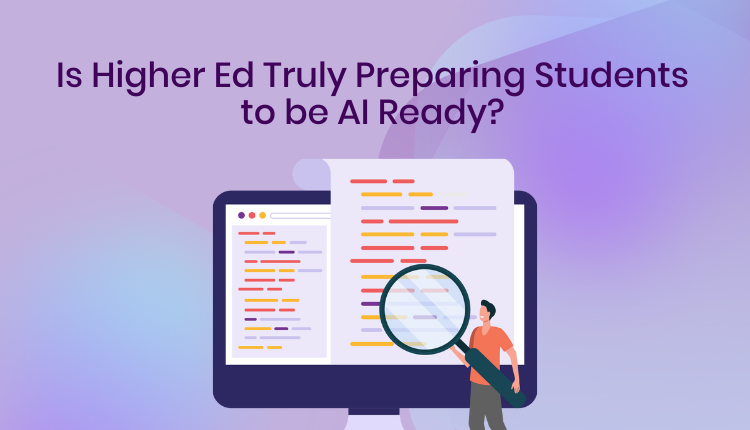In today’s hiring landscape, experience alone isn’t enough. Employers increasingly seek graduates who can collaborate with AI, design smart prompts, evaluate AI-generated content, and make ethical decisions about its use. A 2024 Microsoft study found that 71% of hiring managers would prefer a candidate with AI skills over one with similar experience but no AI capability.
Graduates need the ability to interrogate AI outputs, detect bias, improve responses, and integrate tools ethically into workflows.
What Does AI Literacy Really Mean
Leading researchers describe AI literacy as a combination of:
- Technical fluency – understanding how AI tools work and using them effectively
- Cognitive capacity – evaluating and improving AI-generated content
- Ethical awareness – recognizing bias, ensuring transparency, and making socially responsible decisions
Consider Ning et al. (2025), creators of the A-Factor model. Their 18-item psychometric framework evaluates AI readiness across four core domains: communication, creativity, content evaluation, and collaboration. Validated with over 500 participants, it provides an evidence-based method to assess the depth of AI understanding beyond surface-level usage.
These frameworks make one thing clear: true AI literacy is about reflection and responsibility and not just technical know-how.
How Higher Ed Is Falling Behind
Despite AI’s growing role in the workplace, higher education has been slow to adapt. Many institutions still:
- Ban AI use in assessments, missing the chance to teach critical thinking and ethical integration
- Limit AI training to STEM majors, ignoring its relevance across business, humanities, and the arts
- Provide support to faculty, who are often unprepared to integrate AI into their pedagogy
Many educators are often overwhelmed by the plethora of AI tools available. As a result, students receive inconsistent guidance and sometimes punished for using AI, other times left to navigate it alone.
The Risk of Outdated AI Rules
It’s clear that institutional AI strategies need to evolve to reflect the changing dynamic between students and artificial intelligence. Failure to do so risks:
- Student outcomes – Undermined by missed opportunities to build AI fluency
- Graduate employability – Compromised by insufficient AI readiness
- Institutional reputation – Weakened by a workforce unprepared for AI-driven industries
Institutions must regularly review their assessments to keep pace with evolving AI capabilities and student competencies. Reactive restrictions are ineffective and undermine broader goals to create an AI-ready workforce. To equip students for the future of work, institutional AI policies must move from prohibitive and punitive to proactive and pro-AI proficiency and also empower their academic staff to deliver AI literacy in a way that enhances learning, while safeguarding academic integrity.
What Universities Should Do Differently
The Higher Education Policy Institute (HEPI) research reinforces that:
Students need more institutional support: Only 36% students have received support from their institution to develop AI skills.
AI policies are deterring appropriate AI use: Nearly a third (31%) says that their institution bans or discourages AI use.
A common concern that has led many faculty to adopt strict rules or detection tools is that students often use AI to take shortcuts. However, the real challenge is how AI is being used and whether students are being taught to engage with it ethically and reflectively.
The future of work demands AI fluency, and higher education must lead the way.
This is where tools like DocuMark can support this shift at scale. Rather than detecting AI to punish students, it encourages reflection, authorship, and transparency, helping institutions cultivate responsible AI use across disciplines.
Moving from Small Steps to Big Change
AI is no longer a niche subject taught in advanced computer science courses; it’s the operational language of tomorrow’s workforce. From writing marketing campaigns to synthesizing research and solving real-world problems, AI tools now shape how students work, learn, and think. The question facing universities today isn’t whether students are using AI, it’s whether institutions are teaching them to use it well.
Students encounter AI daily, in their academic or personal lives. But while learners are adapting quickly, many institutions aren’t. This lag is more than a technology gap; it’s a skills gap that could leave a generation of graduates underprepared for careers where AI fluency is the new baseline.
We’re in the midst of a new literacy revolution, one where AI fluency is as fundamental as reading and writing. The institutions that will lead the future aren’t those that ban AI, but those that empower students to use it responsibly, ethically, and creatively.
Tools like DocuMark play a critical role in this shift. By requiring students to document their AI prompts, describe how they refined AI-generated content, and reflect on their writing process, DocuMark transforms AI use into a learning opportunity.
The real opportunity isn’t just to produce AI-literate graduates, but to nurture a generation that can redefine what responsible AI looks like across disciplines. The tools are here. The need is urgent. Now, it’s time for higher education to rise to the challenge.
Schedule a customized demo to explore how DocuMark integrates into your LMS, adapts to your policies, and helps build a culture of responsible AI use across your campus.

